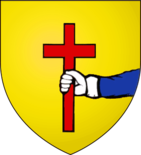Uí Domhnaill
| O'Donnell | |
|---|---|
 Armorial of O'Donnell (one of several) |
|
| Country | Kingdom of Tyrconnell |
| Parent house | Cenél Conaill / Uí Néill |
| Titles |
Cenél Conaill:
O'Donnell:
International titles:
|
| Founded | 13th (5th) century |
| Founder | Conall Gulban |
| Final ruler | Rory Ó Donnell, King of Tyrconnell |
| Current head | Fr. Hugh Ambrose O'Donel, O.F.M. Heir apparent: The 7th Duke of Tetuan |
| Cadet branches | O'Donell von Tyrconnell |
Cenél Conaill:
O'Donnell:
International titles:
The O'Donnell dynasty (Irish: Ó Dónaill or Ó Domhnaill or Ó Doṁnaill; derived from the Irish name Domhnall, which means "ruler of the world", Dónall in modern Irish) were an ancient and powerful Irish family, kings, princes and lords of Tyrconnell (Tír Chonaill in Irish, now County Donegal) in early times, and the chief allies and sometimes rivals of the O'Neills in Ulster.
Like the family of O'Neill, that of O'Donnell of Tyrconnell was of the Uí Néill, i.e. descended from Niall of the Nine Hostages, High King of Ireland at the beginning of the 5th century; the O'Neill, or Cenél nEógain, tracing their pedigree to Eógan mac Néill, and the O'Donnells, or Cenél Conaill, to Conall Gulban, both sons of Niall. Conall was baptised by St. Patrick.
The Roman Emperor Constantine the Great converted to Christianity after a vision before the famous Battle of the Milvian Bridge, having seen a chi-rho in the sky, and thence the motto In Hoc Signo Vinces, telling him he would be victorious with the sign of the cross. The chi-rho was adopted on a banner, the labarum, upheld on a vexillum, which resembled a Christian cross, and in time the motto became associated with the Cross all over Europe. Legend has it that St. Patrick struck the shield of Conall, son of King Niall of the Nine Hostages, with his crosier, called Bachall Isa (the staff of Jesus) inscribing thereon a sign of the cross and told him the same, and baptized him. According to the Life and Acts of Saint Patrick (chapter 138), commissioned by Sir John de Courcy and written by Jocelyn of Furness (c. 1185 AD), St. Patrick took his staff, known as the staff of Jesus, or Bacall Iosa, and struck the shield of Prince Conall, rendering a sign of the Cross on it, “et mox cum baculo suo, qui baculus Jesu dicebatur Crucis signum ejus scuto impressit, asserens neminem de stirpe ejus in bello vincendum qui signum illud”, and thus indicating that he and his offspring would henceforth be victorious in battle if they followed that sign This legend is also described several centuries later in the Lebhar Inghine i Dhomhnaill. His land became Tír Chonaill, Tyrconnell, the land of Conall.
...
Wikipedia
